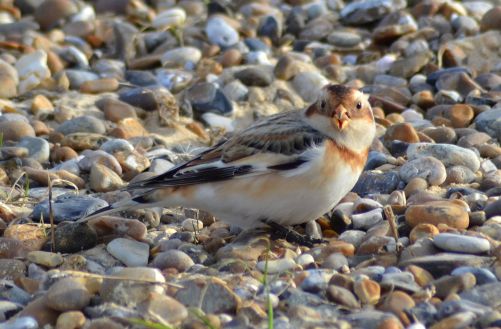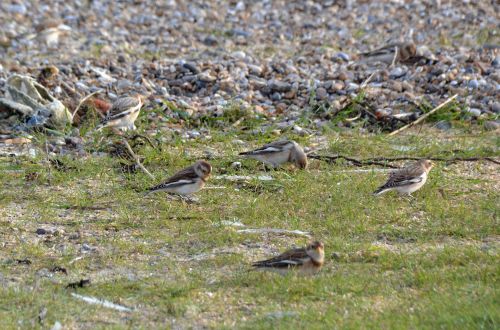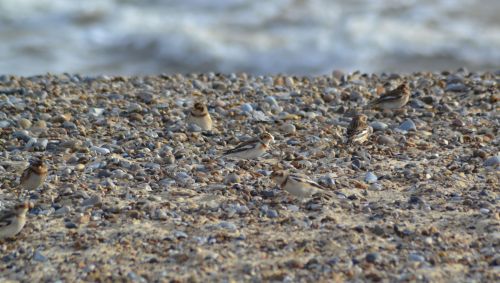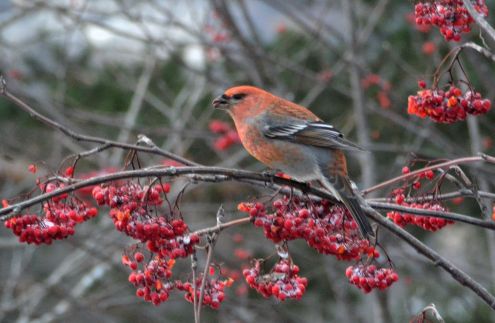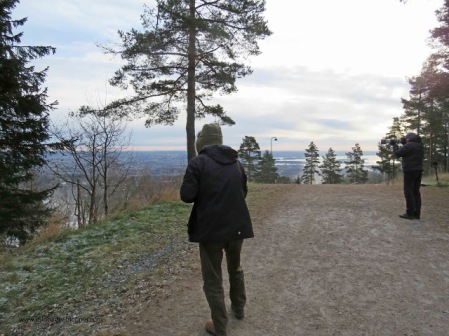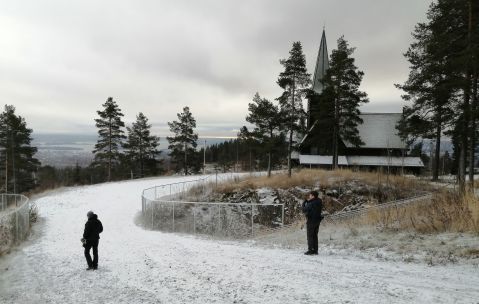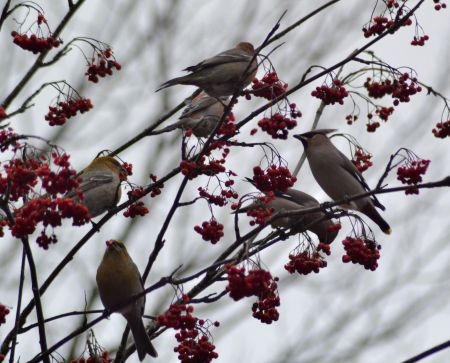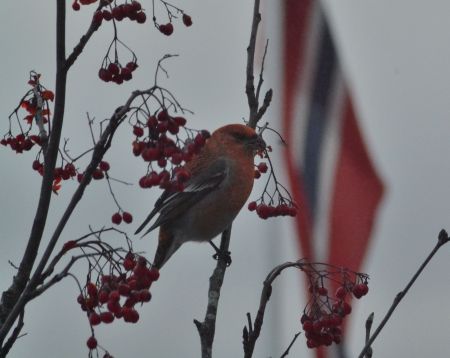When Wednesday’s BirdGuides review of the week told of this bird making an extended stay within an Atlantic Grey Seal colony on the north Lincs coast it seemed like an unmissable opportunity to connect with the only British Skua I had not observed previously. Settled ones on land do not occur too often, so though 180 miles from home is further than my preferred driving distance I at once resolved to go. Like my first Little Auk in Oslo earlier this month, making the trip would be greatly preferable to trying to sea watch fly-bys somewhere.
Personal records of the three other Skua species had all come locally from Oxford’s Farmoor Reservoir: Great in October 2017 (see here), Arctic (Nov 2013) and Long-tailed (Sep 1995). But it would be very unusual for a “Pom” to turn up at such an inland location, and thus lingered a rather glaring omission from my national and life lists. Earlier this autumn another land-bound individual was found early in the day at Langstone Harbour in Sussex, but when I arrived there it had flown off not to be seen again.
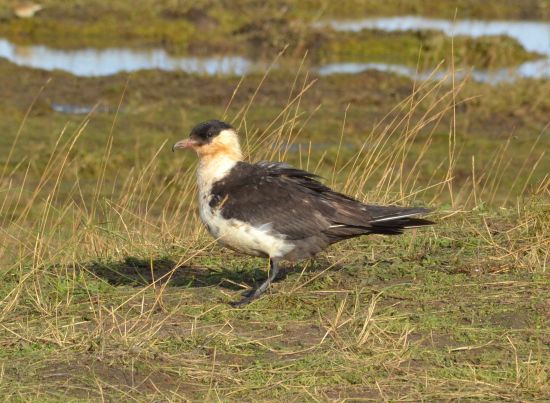
Today’s Pomarine Skua (adult)
The weather was due to change for the better on Friday and so at around 9:30am I arrived at Donna Nook NNR in cold and clear conditions. One of the car park volunteers said the bird was still present, and on enquiring of a departing birder I was pointed towards a spot where the presence of green clad optics carriers indicated where my quest must be. And there, sitting out on the salt marsh alternately dozing and preening, was my first ever Pomarine Skua – things this time were as simple as that.
Numbers of these seabirds are seen on migration around British coasts in both spring, when I understand a particular wind direction is needed to encounter them, and autumn. This one has possibly reasoned that the all day, as much as it likes buffet offered here by the plentiful placentae that litter such a large breeding seal colony is preferable to moving on. But rather worryingly it is also said to have an injured leg and so may just have been left behind.
Before long the Pom took to the air then landed besides a placenta a few metres within the viewing area boundary fence, a brute of a bird. This was a picture opportunity such as all the birders present craved, and the object of our attention set about tearing at its meal with typical Skua-like relish. A lady standing next to me said if she photo-shopped out the after birth she would then have a nice picture. I have since seen the same view expressed on another Oxon blog and must confess to not seeing what the sensitivity is here.
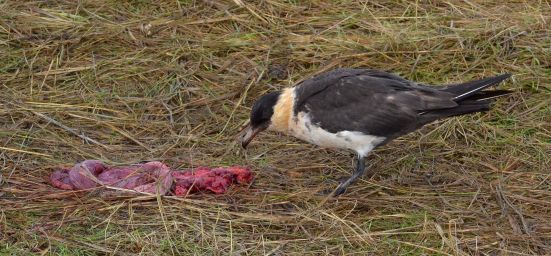
Were I a photographer these are definitely the “shots” I would want. The food source is after all why the bird was here offering such exceptional views of itself. I am also not either a doctor or biologist and so open to correction, but were we not all once followed into the world by one of these perfectly natural items that nourished and allowed us to breathe in the womb? No … there’s nothing wrong with a nice bit of placenta, as this Pom clearly agrees.
Having gained such acceptable studies of this latest life list addition, I next turned my attention to its hosts. The seals were possibly the most awe inspiring wildlife spectacle involving large animals I have enjoyed since experiencing Florida’s Alligators in January 2018. An information board today announced a recent count of 469 bulls and 1629 cows on site, while 1554 pups have been born so far in the current season.
Donna Nook NNR is one of four Atlantic Grey Seal colonies on the English east coast, the others being Blakeney and Horsey in Norfolk, and the Farne Islands. The Lincs Wildlife Trust administered site covers around 10 km of coastline and consists of dunes, slacks and inter-tidal areas. Deposition of material from the River Humber has resulted in mud flats offshore, and the advancing dunes have trapped areas of salt marsh behind them. Every November and December large numbers of seal cows come ashore to give birth, before being mated again by the waiting bulls.
The first pups are born in early November, with numbers peaking around the time of my visit. How rapidly these grow was all too apparent today, and after 18 days the young seals are weaned and the cows return to sea. After moulting into their first adult coat the juveniles follow and by January the beach is empty again. Lesser numbers of the smaller Common Seal also breed at Donna Nook.
The uniformly dark-toned bulls are impressive beasts indeed, up to 2.2 metres in length and weighing up to 300 kg. Here and there I observed them halfheartedly sparring or attempting to mate, but mostly they just slumbered their time away. Some bore the kind of battle scars I have grimaced at in many a wildlife documentary. There seemed to be a concentration of very large bulls out on the tide-line. Cows are pale with darker patches, growing to 1.8 metres long and weighing up to 150kg, and mostly give birth to a single pup each season.
It was of course the pups (pictured above) that stole the show. Like many of the adults they seemed to prefer lying on their backs in variously comical poses, and would roll around, smile and chuckle just like human babies. Their “cute factor” is understandably what brings large numbers of visitors to this NNR, necessitating a one-way system through lanes out from the nearest village of North Somercotes and back. Parking on site is £4 / vehicle and must be a very welcome source for funding reserve management.
Around midday I returned to my car for a sandwich and to retrieve money for the donations box. Many more general public were now arriving and I was amused by the perfectly white pumps heading in the other direction into a muddy area behind the sea wall that had been flooded just a day earlier. A few ladies were attired straight from the high street or possibly somewhere more exclusive, and two fellow multi-layered welly wearers I joked with said they had seen a man dressed in running shorts in the very chill wind.
Returning to the viewing area I sought out the Pomarine Skua again and soon relocated it. The light had improved somewhat and it was now that the lead image in this post and those immediately above were gained. Then at around 1 pm I headed for home, completing the four-hour return journey without even a loo stop or batting an eyelid. Maybe I should go beyond range more often, and this had certainly been an uplifting day out.




















